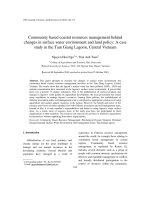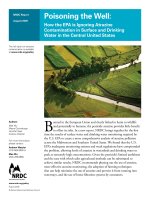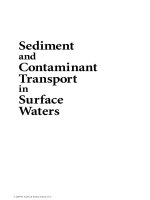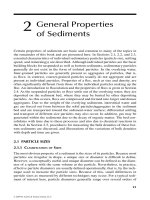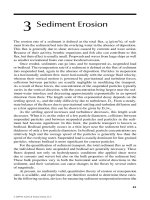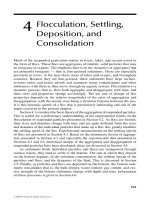Lead in surface water
Bạn đang xem bản rút gọn của tài liệu. Xem và tải ngay bản đầy đủ của tài liệu tại đây (236.72 KB, 13 trang )
Group 2
: LEAD IN SURFACE WATER
Name: LE HONG MINH
NGUYEN TA NAM
NGUYEN VIET HA
HA CONG DUC
NGUYEN DANH LAN
An Overview
Lead has been identified in at least 1,272 of the 1,684 hazardous waste sites that have
been proposed for inclusion on the EPA National Priorities List (NPL) (HazDat 2006).
However, the number of sites evaluated for lead is not known.
Lead is dispersed throughout the environment primarily as the result of anthropogenic
activities. In the air, lead is in the form of particles and is removed by rain or
gravitational settling. The solubility of lead compounds in water is a function of pH,
hardness, salinity, and the presence of humic material. Solubility is highest in soft,
acidic water. The sink for lead is the soil and sediment. Because it is strongly
adsorbed to soil, it generally is retained in the upper layers of soil and does not leach
appreciably into the subsoil and groundwater. Lead compounds may be transformed in
the environment to other lead compounds; however, lead is an element and cannot be
destroyed. Anthropogenic sources of lead include the mining and smelting of ore,
manufacture of lead-containing products, combustion of coal and oil, and waste
incineration. Many anthropogenic sources of lead, most notably leaded gasoline, leadbased paint, lead solder in food cans, lead-arsenate pesticides, and shot and sinkers,
have been eliminated or strictly regulated due to lead’s persistence and toxicity.
Because lead does not degrade, these former uses leave their legacy as higher
concentrations of lead in the environment.
Plants and animals may bioconcentrate lead, but lead is not biomagnified in the
aquatic or terrestrial food chain.
Why we study about lead pollution?
The general population may be exposed to lead in ambient air, foods, drinking water,
soil, and dust. Segments of the general population at highest risk of health effects
from lead exposure are preschool-age children and pregnant women and their fetuses.
Within these groups, relationships have been established between lead exposure and
adverse health effects. Other segments of the general population at high risk include
individuals living near sites where lead was produced or disposed.
Potential for human exposures
Human exposure to lead above baseline levels is common. Baseline refers to the
naturally-occurring level of lead in soil or dust that is not due to the influence of
humans. Some of the more important leadexposures have occurred as a result of living
in urban environments, particularly in areas near stationary emission sources (e.g.,
smelters); consumption of produce from family gardens; renovation of homes
containing lead-based paint; pica (an abnormal eating habit in children); contact with
interior lead paint dust; occupational exposure; secondary occupational exposure (e.g.,
families of workers using lead); smoking; and wine consumption. Higher than normal
exposures may also occur to residents living in close proximity to NPL sites that
contain elevated levels of lead. The highest and most prolonged lead exposures are
found among workers in the lead smelting, refining, and manufacturing industries.
Source release to environment
While lead is a naturally-occurring chemical, it is rarely found in its elemental form. It
occurs in the Earth’s crust primarily as the mineral galena (PbS), and to a lesser extent
as anglesite (PbSO4) and cerussite (PbCO3). Lead minerals are found in association
with zinc, copper, and iron sulfides as well as gold, silver, bismuth, and antimony
minerals. It also occurs as a trace element in coal, oil, and wood. Lead released from
natural sources, such as volcanoes, windblown dust, and erosion, are minor compared
with anthropogenic sources.
Industrial sources of lead can result from the mining and smelting of lead ores, as well
as other ores in which lead is a by-product or contaminant. In these processes, lead
may be released to land, water, and air. Electrical utilities emit lead in flue gas from
the burning of fuels, such as coal, in which lead is a contaminant. Because of the large
quantities of fuel burned by these facilities, large amounts of lead can be released.
I. Sources of lead
Lead appear in surface water almost caused of human activities, from building,
produce processes...Lead waterworks were often applied in some previous decades,
and these may still be present in old buildings. Lead from pipes may partially dissolve
in the water flowing through. Lead may bind to carbonate, therefore lower amounts of
lead dissolve in hard water. Inside the pipes, a layer of hardly soluble alkalic lead
carbonate is formed. This layer functions as a protective coating for the underlying
lead of the pipes.
Despite its toxicity, lead (II) acetate was applied from the 19th century until now, to
sweeten wine and other beverages and food stuffs. The lead compounds are collected
and store in surface water in many years.
Mining industry is also the source that increase the concentration of lead compounds
in surface water.Water pollution containing lead compounds derived from lead ores in
the mining industry was first mentioned by architect Vitruvius, in 20 B.C., when he
gave out a warning of its health effects. In Rome lead was often released as a by-
product of silver mining.
Lead white, an alkalic lead carbonate (2PbCO3.Pb(OH)2), is a white pigment. It is no
longer applied because of its extreme toxicity. Selling tubes of lead white is now
prohibited in the European Union.
Organic lead is applied in petroleum production, and inorganic lead compounds are
applied for battery and paint production.
Most industrially processed lead is applied for fabricating computer and TV screens.
The lead compound tetra-ethyl lead is applied as an additive in fuels. This organic
lead compounds is quickly converted to inorganic lead, and ends up in water,
sometimes even in drinking water. Fortunately, this form of release of lead is less and
less abundant.
In architecture lead is applied in roofs and in stained glass windows. Generally, lead
dissolved or suspended in wastewater mostly stems from streets, pipes and soils.
In The Netherlands, lead in food causes about half of the human lead exposure. Lead
was also used in paint to add color, improve the ability of the paint to hide the surface
it covers, and to make it last longer. In 1978 the federal government banned lead paint
for use in homes. Homes built before 1978 probably contain lead-based paint. Painted
toys and furniture made before 1978 may also contain lead-based paint. Lead-based
paint becomes a concern when it chips, turns into dust, or gets into the soil.
All sources above release lead and lead compounds and it will distribute in also
surface and ground water.
II. Fate of lead
1. Physical properties:
Lead is a heavy, soft, gray solid. It is both ductile and malleable. Ductile means
capable of being drawn into thin wires. Malleable means capable of being hammered
into thin sheets. It has a shiny surface when first cut, but it slowly tarnishes (rusts) and
becomes dull. Lead is easily worked. "Working" a metal means bending, cutting,
shaping, pulling, and otherwise changing the shape of the metal.
o Phase : Solid
- Color: Bluish-White
- Luster: A shine or glow
- Malleability: Capable of being shaped or bent
- Conductivity: Poor transmission of heat or electricity
- Relatively soft
- Tensile: It can be stretched without breaking
- Density: 11.34 g.cm-3 at 20°C
- Melting point: 327 °C
- Boiling point:1755 °C
2. Chemical properties
chemical symbol: Pb (originates from the word “plumbum” which is the latin name
for lead)
o Reactivity with water: The surface of metallic lead is protected by a thin layer of lead
oxide, PbO. It does not react with water under normal conditions.
o
Oxidation: Does not readily react with oxygen in the air at normal condition. Only
upon heating lead to 600-800°C does lead react with oxygen in air to from lead oxide,
PbO.
o
o
2Pb(s) + O2(g) → 2PbO(s)
Flammability: Does not burn
Reaction of lead with the halogens: Lead metal reacts vigorously with fluorine, F2, at
room temperature and chlorine, Cl2, on warming to form the poisonous dihalides
lead(II) fluoride, PbF2, and lead(II) chloride, PbCl2, respectively.
Pb(s) + F2(g) → PbF2(s)
Pb(s) + Cl2(g) → PbCl2(s)
o Reactivity with acids: The surface of metallic lead is protected by a thin layer of lead
oxide, PbO. This renders the lead essentially insoluble in sulphuric acid, and so, in the
past, a useful container of this acid. Lead reacts slowly with hydrochloric acid and
nitric acid, HNO3. In the latter case, nitrogen oxides are formed together with lead(II)
nitrate, Pb(NO3)2.Corrosion: Very resistant to corrosion but tarnishes upon exposure
to air
o Reaction of lead with bases: Lead dissolves slowly in cold alkalis to form plumbites.
o Toxicity: Toxic
Common oxidation states: +2, +4 (+2 is most common)
Chemical properties of Pb2+
o
With CL
In solution have ion clorua, Pb2+ react with Cl- form precipitant
Pb2+(aq) + 2Cl-(aq) <-> PbCl2(s) (Slow precipitation rate)
When Cl- excess, precipitant dissolve because of forming complex ion
tetrachloroplumbate(II)
PbCl2(s) + 2CL-(aq) <-> [PbCl4]2-(aq)
o
With Sulfate
Lead ion create precipitation with sulfate ion
Pb2+(aq) + SO42-(aq) <-> PbSO4(s)
PbSO4 solute in trong base or acetate salt
PbSO4 + 4OH- <-> [Pb(OH)4]2-(aq) + SO2-(aq)
PbSO4 + 2CH3COO-(aq) <-> Pb(CH3COO)2-(aq) + SO42-(aq)
o
With ammonia solution
Ion Pb2+ react with ammonia solution form single salt precipitation (ex: Pb2O(NO3)2 )
appear more than Pb(OH)2:
Pb2+(aq) + 2NH3(aq) + 3H2O(l) + 2NO3-(aq) <-> Pb2O(NO3)2(s) + H2O(l) + 2NH4+(aq)
Precipitant does not solute when NH3 excess.
o
With strong base
When react with strong base solution,Pb2+ form black precipitation. Precipitant solute
when base excess.
Pb2+(aq) + OH-(aq) <-> Pb(OH)2(s)
Pb(OH)2(s) + 2OH-(aq) <-> [Pb(OH)4)]2-
o Biologic Fate of Lead
Biologic fate of lead once it enters the human body depends on a variety of factors
including nutritional status, health, and age.
+ Adults typically absorb up to 20% of ingested lead.
+ Most inhaled lead in the lower respiratory tract is absorbed.
+ Most of the lead that enters the body is excreted in urine or through biliary clearance
o
Lead in the Blood
+ The half-life of lead in adult human blood has been estimated to be from 28-36 days
+ Approximately 99% of the lead in blood is associated with red blood cells
+Blood lead (BLL) is also important because the BLL is the most widely used
measure of lead exposure.
o
Lead in Mineralizing Tissues (Bones and Teeth)
The bones and teeth of adults contain about 94% of their total lead body burden; in
children, the figure is approximately 73%.
Two physiological compartments appear to exist for lead in cortical and trabecular
bone
+ The inert component stores lead for decades. Under certain circumstances, this
apparently inert lead will leave the bones and reenter the blood and soft tissue organs.
+ The labile component readily exchanges bone lead with the blood.
III. lead process in surface water
Lead is one of the heavy metals greatly affect the environment
pollution because it is capable of long-term accumulation in the body
and cause toxicity to humans, aquatic animals through the food chain.
Redox reactions of lead in the environment as follows:
Pb+2 + 2H2O «» PbO2 + 4H+ 2eLead Pb2 + is relatively stable, strong affinity. Therefor, it can replace other metals in
the structure of the enzyme. Most inorganic salts of lead Pb2 + (PBS, PbCO3,
PbSO4,) is less soluble substances, so lead content in groundwater is relatively low.
They can create hydrogen, carbonate, sulfate and carboxyl complexes in the
atmosphere. Lead hydoxide is amphoteric hydroxide, so solubility can be increased
with increasing pH and increasing concentrations of CO2 in the liquid phase:
Pb(OH)2 + OH- «» Pb(OH)3-
In the hydrosphere, existing compounds Pb2 + is hydrated, the soluble reaction, lead
compounds in suspended form ... Lead content of natural water or water feeding for
living activity is determined by a number of factors such as:
- The formation of complexes with inorganic ligands or organic sector;
- The dissolution or precipitation of lead compounds;
- Adsorption of lead compounds on colloidal dust particles, or organic colloidal
particles;
- The transformation of living organisms;
- The flocculation or coagulation....
For example, the standard of the World Health Organization for the maximum
permitted concentration of lead in drinking water was 0:05 mg / liter, coastal water,
the lake is 0.1 mg / liter ...
Groundwater contains less lead (0.01 mg / liter), seawater contains 0.03
micrograms/ liter. In the water flowing through the pipelines, we can observe that lead
level can up to 100 micrograms/ liter. Lead compounds in water-soluble form or
suspended in the water will flow into the sea. A significant portion of lead compounds
go to the living organisms in the food chain or be retained in the sediment. Fresh
water is mainly in the form of lead carbonate complexes, sea water contain lead
compounds mainly in the form of chloride complexes, while in water of land, lead in
the complex shape of humic or fulvic acid.
IV. Environmental issues
People, animals, and fish are mainly exposed to lead by breathing and ingesting it in
food, water, soil, or dust. Lead accumulates in the blood, bones, muscles, and fat.
Infants and young children are especially sensitive to even low levels of lead.
•
Damages organs - Lead causes damage to the kidneys, liver, brain and nerves,
and other organs. Exposure to lead may also lead to osteoporosis (brittle bone disease)
and reproductive disorders.
•
Affects the brain and nerves - Excessive exposure to lead causes seizures,
mental retardation, behavioral disorders, memory problems, and mood changes. Low
levels of lead damage the brain and nerves in fetuses and young children, resulting in
learning deficits and lowered IQ.
•
Affects the heart and blood - Lead exposure causes high blood pressure and
increases heart disease, especially in men. Lead exposure may also lead to anemia, or
weak blood.
•
Affects animals and plants - Wild and domestic animals can ingest lead while
grazing. They experience the same kind of effects as people who are exposed to lead.
Low concentrations of lead can slow down vegetation growth near industrial facilities.
•
Affects fish - Lead can enter water systems through runoff and from sewage
and industrial waste streams. Elevated levels of lead in the water can cause
reproductive damage in some aquatic life and cause blood and neurological changes in
fish and other animals that live there.
What are the environmental effects of lead in water?
Lead and lead compounds are generally toxic pollutants. Lead(II)salts and organic
lead compounds are most harmful ecotoxicologically. Lead salts are attributed to
water hazard class 2, and consequently are harmful. The same applies to lead
compounds such as lead acetate, lead oxide, lead nitrate, and lead carbonate.
Lead limits plant chlorophyll synthesis. Nevertheless, plants can take up high levels of
lead up to 500 ppm from soils. Higher concentrations negatively influence plant
growth. Through plant uptake, lead enters food chains. Consequently, lead pesticide
application is prohibited in most countries. Lead accumulates in organisms, sediments
and sludge. Lead in wastewater mostly stems from streets and roofs.
Lead exists as four stable isotopes, and no less than 26 instable isotopes.
What are the health effects of lead in water?
The human body contains approximately 120 mg of lead. About 10-20% of lead is
absorbed by the intestines. Symptoms over overexposure to lead include colics, skin
pigmentation and paralysis. Generally, effects of lead poisoning are neurological or
teratogenic. Organic lead causes necrosis of neurons. Inorganic lead causes axonal
degeneration and demyelination. Both species of lead may cause cerebral oedema and
congestion. Organic lead compounds are absorbed quicker, and therefore pose a
greater risk. Organic lead derivates may be carcinogenic. Women are generally more
susceptible to lead poisoning than men. Lead causes menstrual disorder, infertility and
spontaneous abortion, and it increases the risk of stillbirth. Foetuses are more
susceptible to lead poisoning than mothers, and generally foetuses even protect
mothers from lead poisoning. A long time ago lead was applied as a measure of birth
control, for example as a spermicidal, and to induce abortion.
Children may absorb a larger amount of lead per unit body weight than adults (up to
40%). Consequently, children are generally more susceptible for lead poisoning than
adults. Symptoms include lower IQs, behavioural changes and concentration disorder.
Lead accumulates in leg tissue. The most severe type of lead poisoning causes
encephalopathy.
Lead toxicity is induced by lead ions reacting with free sulfydryl groups of proteins,
such as enzymes. These are deactivated. Furthermore, lead may interact with other
metal ions.
V. References
1. Hóa học môi trường, Đặng Kim Chi, Nxb Khoa học và kĩ thuật.
2. Nghiên cứu khảnăng tách loại Pb2+trong nước bằng nano sắt kim loại, Nguyễn Thị Nhung*,
Nguyễn ThịKim Thường, Tạp chí Khoa học ĐHQGHN, Khoa học Tự nhiên và Công nghệ 24
(2008) 305-30.
3. Lead-210 and polonium-210 in the surface water of the Pacific, SHIZUO TSUNOGAI and
YOSHIYUKI NOZAKI, Geochemical Journal, Vol. 5, pp. 165 to 173, 1971.
4. Effects of blending of desalinated water with treated surface drinking water on copper and lead
release, Haizhou Liu, Kenneth D. Schonberger, Gregory V. Korshin, John F. Ferguson, Paul
Meyerhofer, Erik Desormeaux, Heidi Luckenbach, Water Research, Volume 44, Issue 14, July
2010, Pages 4057-4066.
5. Water contamination: Impact of tin-lead solder, K.S. Subramanian, V.S. Sastri, M. Elboujdaini,
J.W. Connor, A.B.C. Davey, Water Research, Volume 29, Issue 8, August 1995, Pages 18271836.
6. Lead speciation in surface waters of the eastern North Pacific, Gabriele Capodaglio, Kenneth H
Coale, Kenneth W Bruland, Marine Chemistry, Volume 29, 1990, Pages 221-233

